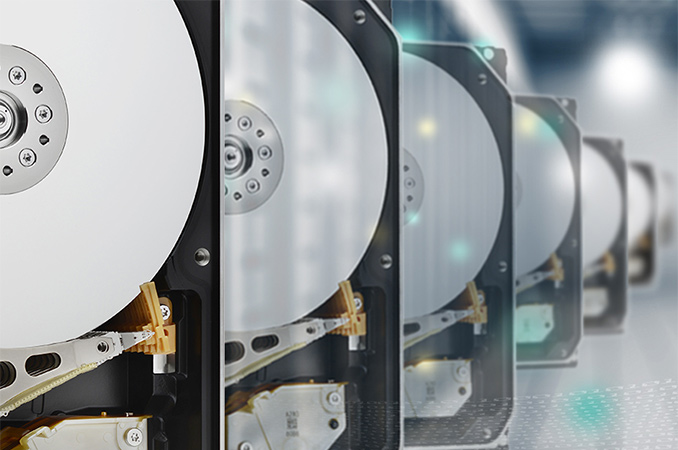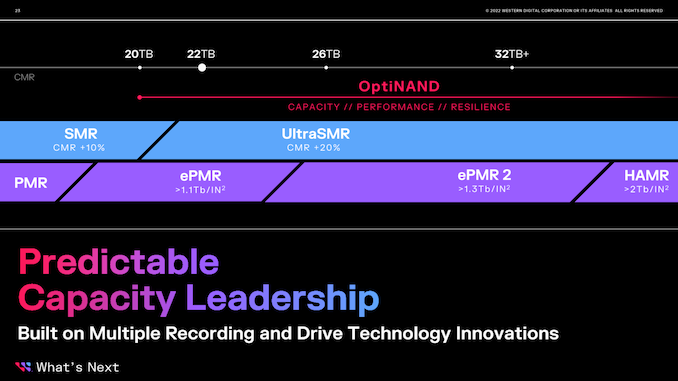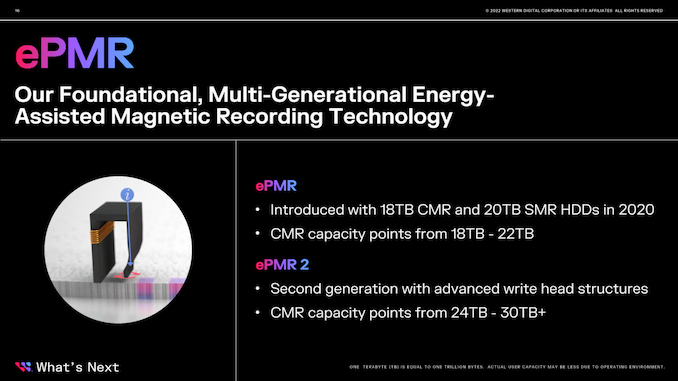Western Digital Estimates HAMR HDDs to Emerge in 1.5 Years
by Anton Shilov on June 12, 2023 8:30 AM EST
Western Digital is somewhat behind its rival Seagate in adopting heat-assisted magnetic recording (HAMR), which promises radical improvements to areal density and HDD capacities. Still, the company expects hard drives that use this recording method to enter mass production in the next 1.5 years. This technology will open doors for nearline drives offering 40 TB – 50 TB capacities in the coming years.
Seagate recently said it was months away from introducing its 32 TB nearline hard drives featuring its HAMR technology, with 36 TB and 40 TB HDDs to follow. The introduction of 32 TB hard drives will undoubtedly put Seagate in a leading position as far as capacity is concerned, as the highest capacity drive that Western Digital has today is its Ultrastar DC HC670 26 TB featuring UltraSMR set of technologies. At a recent conference, financial analysts asked Western Digital when the company expects its HAMR HDDs to emerge. The firm envisions these drives to enter mass production in circa 1.5 years.
"On the HAMR side, we are probably one year to 1.5 years plus before we get sort of volume production anyway," said Wissam Jabre, the chief financial officer of Western Digital, at the Bank of America Securities 2023 Global Technology Conference (via SeekingAlpha).
HAMR is a highly complex technology. It requires novel platters capable of enduring intense local heat of approximately 450°C or higher (generated using a laser with an ~810 nm wavelength and a ~20 mW power) without deforming over time. These platters are expected to be made from glass substrates and covered with a thin Fe-Pt alloy magnetic layer to ensure reliability and resist eventual deformation.
"HAMR could be one of the next on the roadmap," said Jabre. "[…] Our engineering teams have done a lot of R&D around [HAMR] […], it requires a lot of work on the material science as well as the physics. But also, much work is required in terms of commercialization, meaning being able to manufacture at scale, ensuring the yields are where they need to be, and having a reliable product that can last for several years. So, it takes time to get there."
All HDD makers have been working on HAMR HDDs for well over a decade, but only Seagate decided to bet on HAMR boldly. In contrast, Toshiba and Western Digital adopted energy-assisted perpendicular magnetic recording (ePMR) and microwave-assisted magnetic recording (MAMR) before adopting HAMR.
Western Digital's roadmap includes the 2nd Generation ePMR 2 platform, which allows for areal densities over 1.3 Tb/inch2 (an 18% over ePMR). Such areal density will enable the company to build 3.5-inch platters with a capacity of over 3.5 TB. Thus Western Digital will be able to offer HDDs with a ~36 TB capacity featuring 10 of such disks in the coming quarters. Meanwhile, the company says this technology will be used for CMR HDDs with 24 TB – 30+ TB capacity points.
Of course, the key question is when precisely such drives are set to be announced, qualified, and shipped. But at least it looks like Western Digital is set to stay competitive with Seagate regarding HDD capacities for the foreseeable future.
As for HAMR, Western Digital expects this recording technology to enable areal densities higher than 2 Tb/inch2, which allows it to build ~5.4 TB 3.5-inch platters, opening doors for HDDs with capacities of around 50+ TB.













16 Comments
View All Comments
Igor_Kavinski - Tuesday, June 13, 2023 - link
You funny! Golden Buzzer you deserve!sheh - Tuesday, June 13, 2023 - link
I don't recall seeing any retention specs for Optane?LiKenun - Friday, June 16, 2023 - link
Apparently, the retention is poor enough that I’ve heard an Optane drive plugged in from cold storage will take some time to warm up by checking every bit for corruption. During that period, performance is slightly degraded. I’ll have to find the source, but I believe it pertains to benchmarking Optane P4800X.Silver5urfer - Tuesday, June 13, 2023 - link
It was Intel Optane / 3DXpoint. The investors at Intel do not care they only want their money to exponentially grow, so they dumped Intel and shorted it and moved to Apple, the ever stable WallSt fav. Intel is fumbling because of Mobile processors like ARM use and throw garbage outsell x86 parts and more people are not using Computers and also rather using stupid mobiles over a PC.Ultimately on top of Intel's failures in the Lithography and CPU business which is bread and butter they did not care and fired Jim Keller on top. This company is being mismanaged since decade. Now we do not have any Optane successor.
Look at PCIe5.0 NVMe SSDs, esp 2280 total joke. Phison is never used in HPC only now they are starting and finally the only good thing is HDD technology.
If you want a reliable storage go for WD Gold or WD Ultrastar the true Datacenter series. WD's OptiNAND is a good tech but I think HAMR will take over ePMR. 50TB HDDs we need them badly.
ballsystemlord - Tuesday, June 13, 2023 - link
It's odd that you'd condemn HDDs for failing so quickly only to then say that SSD lifespan should increase.But even if you wanted an increase in lifespan, why would manufacturers do that when they can sell more product by allowing SSDs to have a shorter lifespan?
People tend to think short term, so they buy the cheapest SSD. I've literally spoken to people who buy QLC SSDs. "They're so cheap," they say, "It's a good deal," they say. Never asking what will happen in a few years time. And this is without mentioning that a full drive write to a QLC SSD has been show to be slower than writing to an HDD.
ballsystemlord - Thursday, June 15, 2023 - link
EDIT: This was supposed to be in reply to PeachNCream 's comment above.